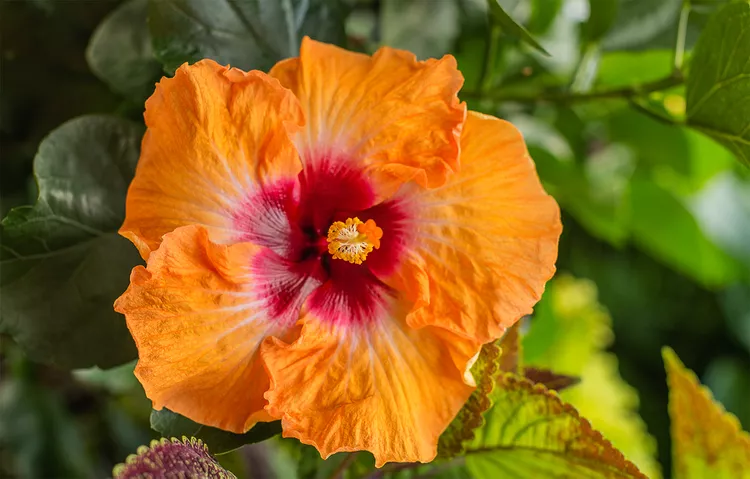Few plants say “summer” quite like hibiscus with their big, colorful flowers. And pruning hibiscus plants correctly is key to getting the best flower show in late summer, and ensuring blooms keep coming into fall. Pruning begins with identifying which type of hibiscus you are growing. Once you know that, pruning is a cinch. In general, these plants have straightforward and minimal pruning needs. Here’s how to prune any type of hibiscus with confidence.
1. Identify Your Hibiscus
Start by identifying the type of hibiscus you have. Different varieties will require unique pruning techniques, so it's important to know what you're working with.
- Tropical hibiscus (Hibiscus rosa-sinensis) is typically grown in a pot and taken inside during winter. This warm-climate native is hardy in USDA Zones 9–12 and has glossy foliage and brightly-hued flowers.
- Rose mallow (Hibiscus moscheutos), also called hardy hibiscus, is a perennial hibiscus that is beloved for its massive flowers and late summer and fall flowering window. Rose mallow dies back to the ground in winter and is a perennial in Zones 4–9.
- Rose of Sharon (Hibiscus syriacus) is a deciduous shrub. Its flowers unfurl repeatedly from mid-summer until fall. Rose of Sharon is hardy in Zones 5–9.
2. Remove Dead, Damaged, or Diseased Stems Promptly
Grab a clean pair of pruners and cut away any dead, damaged, or diseased wood on any type of hibiscus at any time of year. Removing compromised stems goes a long way toward preventing disease or stopping it before it spreads to nearby stems.
3. Prune Rose Mallow in Spring
Rose mallow is an ultra-easy-care hibiscus. It dies back to ground level each winter. Prune it by snipping off the dead stems in spring. New stems will emerge from the root system in late spring. Be patient as you wait for signs of life—this perennial hibiscus is one of the last perennials to emerge from the ground in May or June.
4. Cut Back Rose of Sharon in Late Winter
Pruning rose of Sharon in late winter before the leaves emerge promotes a full, robust landscape shrub. Remove a few inches from the branch tips using hand pruners or pruning shears. Tip pruning spurs the plant to create new branches further down the stem, resulting in a full shrub.
Like all hibiscus plants, rose of Sharon blooms on new wood—stems that emerge in the current season. By pruning before new leaves and new growth start, you avoid snipping off any of the plant’s summer flowers.
5. Tame Overgrown Rose of Sharon in Spring
Rose of Sharon tolerates heavy pruning well. In early spring, reduce the size of an overgrown shrub by cutting the branches back by half their length. For a more natural shape, remove one-third of the shrub’s branches at the base of the plant and cut the remaining branches back by about one-quarter their length. Repeat the pruning process the following year until the desired size is achieved.
6. Prune Tropical Hibiscus in Spring
Tropical hibiscus plants typically spend the cold months indoors before moving outside in spring. The best time to prune is right after you move the plant to its sunny outdoor spot. It’s not unusual for tropical hibiscus to look a little bedraggled after a long winter indoors. Prune wayward branches and remove any dead twigs. Cut a couple of inches of growth off the ends of branch tips to spur the plant to develop new side branches and more flower buds. If the plant is overgrown, remove as much as one-third of the woody growth to reduce its size.
7. Fertilize Tropical Hibiscus After Pruning
Tropical hibiscus benefits from a fertilizer application after pruning. Fertilize plants with a 20-20-20 liquid fertilizer diluted to half strength. Continue fertilizing monthly while the plant is growing outside. Fertilizing isn’t necessary for rose of Sharon and rose mallow.
8. Water Well After Pruning
Pruning spurs plants to produce new growth, and water is essential for healthy growth. Water your hibiscus plants well after pruning them.
9. Avoid Pruning in Summer
Tropical hibiscus, rose of Sharon, and rose mallow all bloom on new growth. Pruning in summer removes new growth and flower buds. The exception is if your plant has damaged or diseased branches, which should be removed any time you notice them.




















